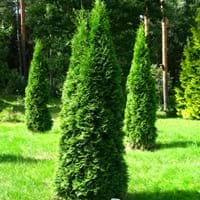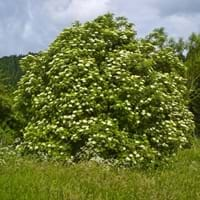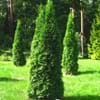Life Span
Perennial
Perennial
Type
Needled or Scaled Evergreen
Flowering Plants, Fruits, Herbs, Shrubs
Origin
Northeastern United States, Mid-Atlantic United States, Southeastern United States, North-Central United States, Central United States, Canada
Australia, South America
Types
Not Available
Adams Elderberry, Black Beauty Elderberry, Black Lace Elderberry, Johns Elderberry, Nova Elderberry
Number of Varieties
Not Available
Habitat
Forests, gardens, Roadsides
Farms, Homesteads, Near organic waste disposal
USDA Hardiness Zone
3-7
4-8
Sunset Zone
A2, A3, 1a, 1b, 2a, 2b, 3a, 3b, 4, 5, 6, 7, 8, 9, 15, 16, 17, 21, 22, 23, 24
2a, 2b, 3a, 3b, 4, 5, 6, 7, 14, 15, 16, 17
Habit
Pyramidal
Upright/Erect
Flower Color
Non Flowering Plant
White
Flower Color Modifier
Bicolor
Not Available
Fruit Color
Green, Light Green
Purple, Red
Leaf Color in Spring
Dark Green
Green
Leaf Color in Summer
Dark Green
Green
Leaf Color in Fall
Olive, Dark Green
Yellow green
Leaf Color in Winter
Dark Green, Brown, Black
Not Available
Leaf Shape
Compound
Compound
Plant Season
Spring, Summer, Fall, Winter
Early Spring
Sunlight
Full Sun, Partial Sun
Full Sun, Part sun
Growth Rate
Medium
Medium
Type of Soil
Clay, Loam, Sand
Loamy, Sandy, Well drained
The pH of Soil
Acidic, Neutral
Slightly Acidic
Soil Drainage
Average
Average
Bloom Time
Spring
Early Spring, Spring
Tolerances
Drought
Pollution
Where to Plant?
Ground
Ground
How to Plant?
Seedlings, Vegetative Reproduction
Grafting, Seedlings
Plant Maintenance
Medium
Medium
Watering Requirements
Average Water Needs
Requires regular watering, Use Mulches to help prevent water loss during hot and windy weather
In Summer
Lots of watering
Lots of watering
In Spring
Moderate
Moderate
In Winter
Average Water
Average Water
Soil pH
Acidic, Neutral
Slightly Acidic
Soil Type
Clay, Loam, Sand
Loamy, Sandy, Well drained
Soil Drainage Capacity
Average
Average
Sun Exposure
Full Sun, Partial Sun
Full Sun, Part sun
Pruning
Prune if you want to improve plant shape, Remove deadheads, Shape and thin as needed
Cut or pinch the stems, No pruning needed in the early stages, Prune for shortening long shoots, Prune if you want to improve plant shape, Prune in winter, Prune ocassionally, Remove deadheads
Fertilizers
All-Purpose Liquid Fertilizer
All-Purpose Liquid Fertilizer
Pests and Diseases
Pests and diseases free
Canker, Leaf spot, Powdery mildew, Stem spot, Tomato Ringspot Virus
Plant Tolerance
Drought
Drought
Flower Petal Number
Single
Single
Fragrant Bark/Stem
Yes
No
Foliage Texture
Fine
Medium
Foliage Sheen
Matte
Matte
Attracts
Bees, Birds
Birds
Allergy
no allergic reactions
Diarrhea, Nausea, Vomiting
Aesthetic Uses
Beautification, Landscape Designing
Not Used For Aesthetic Purpose
Beauty Benefits
Not Available
Not Available
Environmental Uses
Air purification
Air purification
Medicinal Uses
No Medicinal Use
constipation, Fever, Heart problems, High cholestrol, HIV/AIDS, Nerve pain, swine flu
Part of Plant Used
Wood
Flowers, Fruits
Other Uses
Showy Purposes
Not Available
Used As Indoor Plant
No
No
Used As Outdoor Plant
Yes
Yes
Garden Design
Hedges, Screening, Wind Break
Not Available
Botanical Name
THUJA occidentalis 'Techny'
Sambucus nigra
Common Name
White Cedar
Elderberry
In Hindi
Techny Arborvitae
Elderberry
In German
Techny Lebensbaum
Holunderbeere
In French
Techny Arborvitae
Sureau
In Spanish
Techny Arborvitae
Saúco
In Greek
Techny Arborvitae
Elderberry
In Portuguese
Techny Arborvitae
Sabugueiro
In Polish
Techny Tuja
Bez czarny
In Latin
Techny Arborvitae
Elderberry
Phylum
Pinophyta
Magnoliophyta
Class
Pinopsida
Magnoliopsida
Family
Cupressaceae
Adoxaceae
Clade
Dicotyledonous
Angiosperms, Asterids, Eudicots
Tribe
Not Available
Not Available
Subfamily
Not Available
Not Available
Number of Species
Not Available
Season and Care of Techny Arborvitae and Elderberry
Season and care of Techny Arborvitae and Elderberry is important to know. While considering everything about Techny Arborvitae and Elderberry Care, growing season is an essential factor. Techny Arborvitae season is Spring, Summer, Fall and Winter and Elderberry season is Spring, Summer, Fall and Winter. The type of soil for Techny Arborvitae is Clay, Loam, Sand and for Elderberry is Loamy, Sandy, Well drained while the PH of soil for Techny Arborvitae is Acidic, Neutral and for Elderberry is Slightly Acidic.
Techny Arborvitae and Elderberry Physical Information
Techny Arborvitae and Elderberry physical information is very important for comparison. Techny Arborvitae height is 300.00 cm and width 150.00 cm whereas Elderberry height is 9.00 cm and width 8.00 cm. The color specification of Techny Arborvitae and Elderberry are as follows:
Techny Arborvitae flower color: Non Flowering Plant
Techny Arborvitae leaf color: Dark Green
Elderberry flower color: White
- Elderberry leaf color: Green
Care of Techny Arborvitae and Elderberry
Care of Techny Arborvitae and Elderberry include pruning, fertilizers, watering etc. Techny Arborvitae pruning is done Prune if you want to improve plant shape, Remove deadheads and Shape and thin as needed and Elderberry pruning is done Cut or pinch the stems, No pruning needed in the early stages, Prune for shortening long shoots, Prune if you want to improve plant shape, Prune in winter, Prune ocassionally and Remove deadheads. In summer Techny Arborvitae needs Lots of watering and in winter, it needs Average Water. Whereas, in summer Elderberry needs Lots of watering and in winter, it needs Average Water.





